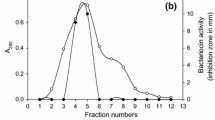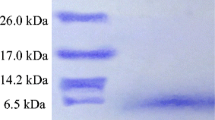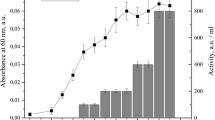Abstract
The new bacteriocin, termed enterocin M, produced by Enterococcus faecium AL 41 showed a wide spectrum of inhibitory activity against the indicator organisms from different sources. It was purified by (NH4)2SO4 precipitation, cation-exchange chromatography and reverse phase chromatography (FPLC). The purified peptide was sequenced by N-terminal amino acid Edman degradation and a mass spectrometry analysis was performed. By combining the data obtained from amino acid sequence (39 N-terminal amino acid residues was determined) and the molecular weight (determined to be 4 628 Da) it was concluded that the purified enterocin M is a new bacteriocin, which is very similar to enterocin P. However, its molecular weight is different from enterocin P (4 701.25). Of the first 39 N-terminal residues of enterocin M, valine was found in position 20 and a lysine in position 35, while enterocin P has tryptophane residues in these positions.


Similar content being viewed by others

References
Anonymous (1992) EEC council directive of 16 June 1992 on milk hygiene (92/46EEC). Official J Eur Com L268/1, 14.9. 1992
Aymerich T, Holo H, Havaerstein LS, Hugas M, Garriga M, Nes IF (1996) Biochemical and genetic characterization of enterocin A from Enterococcus faecium, a new antilisterial bacteriocin in the pediocin family of bacteriocins. Appl Environ Microbiol 62:1676–1682
Aymerich T, Artigas MG, Garriga M, Monfort JM, Hugas M (2000) Effect of sausage ingredients and additives on the production of enterocin A and B by Enterococcus faecium CTC492. Optimisation of in vitro production and anti-listerial effect in dry fermented sausages. J Appl Microbiol 88:686–694
Casaus P, Nilsen T, Cintas LM, Nes IF, Hernandez PE, Holo H (1997) Enterocin B, a new bacteriocin from Enterococcus faecium T136 which can act synergistically with enterocin A. Microbiol 143:2287–2294
Cintas LM, Casaus P, Havarstein LS, Hernandez PE, Nes IF (1997) Biochemical and genetic characterization of enterocin P, a novel sec-dependent bacteriocin from Enterococcus faecium P13 with a broad antimicrobial spectrum. Appl Environ Microbiol 63:4321–4330
Cintas LM, Casaus P, Holo H, Hernandez PE, Nes IF, Havarstein LS (1998) Enterocins L50A and L50B, two novel bacteriocins from Enterococcus faecium L50, are related to staphylococcal hemolysins. J Bacteriol 180:1988–1994
Cintas LM, Casaus P, Herranz C, Havarstein LS, Holo H, Hernandez PE (2000) Biochemical and genetic evidence that Enterococcus faecium L50 produces enterocins L50A and L50B, the sec-dependent enterocin P, and a novel bacteriocin secreted without an N-terminal extension termed enterocin Q. J Bacterial 182:6806–6814
Devriese LA, Laurier L, De Herdt P, Haesebrouck F (1992) Enterococcal and streptococcal species isolated from faeces of calves, young cattle and dairy cows. J Appl Bacteriol 72:29–31
De Vuyst L, Vandamme EJ (1994) Antimicrobial potential of lactic acid bacteria. In: De Vuyst L, Vandamme EJ (eds) Bacteriocins of lactic acid bacteria: microbiology, genetics and applications. Blackie Academic & Professional, London, pp 91–142
De Vuyst L, Callewaert R, Pot B (1996) Characterization and antagonistic activity of Lactobacillus amylovorus DCE471 and large scale isolation of its bacteriocin amylovorin L471. Sys Appl Microbiol 19:9–20
Floriano B, Ruiz-Barba JL, Jímenéz-Díaz R (1998) Purification and genetic characterization of enterocin I from Enterococcus faecium 6T1a, a novel antilisterial plasmid-encoded bacteriocin which does not belong to the pediocin family of bacteriocins. Appl Environ Microbiol 64:4883–4890
Foulquié Moreno MR, Rea M, Cogan T, De Vuyst L (2003) Applicability of a bacteriocin-producing Enterococcus faecium as a co-culture in Cheddar cheese manufacture. Int J Food Microbiol 81:73–84
Foulquié Moreno MR, Sarantinopoulos P, Tsakalidou E, De Vuyst L (2006) The role and application of enterococci in food and health. Int J Food Microbiol 106:1–24
Franz CHMPA, Holzapfel WH, Stiles ME (1999) Enterococci at the crossroads of food safety? Int J Food Microbiol 47:1–24
Franz CHMPA, van Belkum M, Holzapfel WH, Abriouel H, Gálvez A (2007) Diversity of enterococcal bacteriocins and their grouping in a new classification scheme. FEMS Microbiol Rev 31:293–310
Holo H, Nilsen T, Nes IF (1991) Lactococcin A, a new bacteriocin from Lactococcus lactis subsp. cremoris: isolation and characterization of the protein and its gene. J Bacteriol 173:3879–3887
Kawamoto S, Shima J, Sato R, Eguchi T, Ohmomo S, Shibato J, Horikoshi N, Takeshita K, sameshima T (2002) Biochemical and genetic characterization of mundticin KS, an antilisterial peptide produced by Enterococcus mundtii NFRI 7393. Appl Environ Microbiol 68:3830–3840
Lauková A, Mareková M, Javorský P (1993) Detection and antimicrobial spectrum of a bacteriocin-like substance produced by Enterococcus faecium CCM4231. Lett Appl Microbiol 16:257–260
Lauková A (1996) Enterococci associated with the rumen of different ruminants. Biomed Lett 54:27–30
Lauková A, Juriš P (1997) Distribution and characterization of Enterococcus species in municipal sewages. Microbios 97:73–80
Lauková A, Czikková S, Vasilková Z, Juriš P, Mareková M (1998) Occurrence of bacteriocin production among environmental enterococci. Lett Appl Microbiol 27:172–182
Lauková A, Vlaemynck G, Czikková S (2001) Effect of enterocin CCM 4231 on Listeria monocytogenes in Saint-Paulin cheese. Folia Microbiol 46:157–160
Lauková A, Mareková M (2002) A bacteriocin-mediated antagonism by Enterococcus faecium EK13 against Listeria innocua in tofu. Arch Lebesnmittelhyg 53:25–48
Lauková A, Turek P, Mareková M, Nagy J (2003) Use of ent M, new variant of ent P to control Listeria innocua in experimentally contaminated Gombasek sausage. Arch Lebensmittelhyg 54:25–48
Lauková A, Guba P, Nemcová R, Mareková M (2004) Inhibition of Salmonella enterica serovar Duesseldorf by enterocin A in gnotobiotic quails. Vet Med Czech 49:47–51
Mareková M, Lauková A, De Vuyst L, Skaugen M, Nes IF (2003) Partial characterization of bacteriocins produced by environmental strain Enterococcus faecium EK13. J Appl Microbiol 94:523–530
Morovský M, Pristaš P, Czikková S, Javorský P (1998) A bacteriocin-mediated antagonism by Enterococcus faecium BC25 against ruminal Streptococcus bovis. Microbiol Res 153:277–281
McAuliffe O, Ross RP, Hill C (2001) Lantibiotics: structure, biosynthesis and mode of action. FEMS Microbiol Rev 25:285308
Muller T, Ulrich A, Ott EM, Muller M (2001) Identification of plant-associated enterococci. J Appl Microbiol 91:268–278
Nes IF, Diep DB, Havarstein LS, Brurberg MB, Eijsink V, Holo H (1996) Biosynthesis of bacteriocins in lactic acid bacteria. Antonie Leeuwenhoek 70:113–128
Nes IF, Holo H, Fimland G, Hildeng-Hauge H, Nissen-Meyer J (2002) Unmodified peptide-bacteriocins (Class II) produced by lactic acid bacteria. In: Dutton CJ, Haxell MA, Mc Arthur HAI, Wax RG (eds) Peptide antibiotics. Marcel Decker, New York, pp 81–115
Sader HS, Pfaller MA, Tenover FC, Hollis RJ, Jones RN (1994) Evaluation and characterization of multiresistant Enterococcus faecium from 12 US medical centers. J Clin Microbiol 32:2840–2842
Sparo MD, Castro MS, Andino PJ, Lavigne MV, Ceraini C, Gutiérrez GL, Fernández MM, De Marzi MC, Malchiodi EL, Manghi MA (2006) Partial characterization of enterocin MR99 from corn silage isolate of Enterococcus faecalis. J Appl Microbiol 100:123–134
Schleifer KH, Kilppär-Bälz R (1987) Molecular and chemotaxonomic approaches to the classification of streptococci, enterococci and lactobacilli: a review. Syst Appl Microbiol 10:1–19
Skalka B, Pillich J, Pospíšil L (1983) Further observations on Corynebacterium renale as an indicator organism in the detection of exfoliation-positive strains Staphylococccus aureus. Zentralbl Bakteriol Hyg A256:168–174
Švec P, Sedláček I, Pantuček R, Devriese LA, Doškař J (2001) Evaluation of ribotyping for characterization and identification of Enterococcus haemoperoxidus and Enterococcus moraviensis sp. Nov., isolated from water. Int J Syst Evol Microbiol 51:1567–1574
Acknowledgments
This work was supported by the project No. 2/5139/27 of the Slovak Scientific Agency VEGA and on the base of financial support of Dr. M. Mareková by Research Council of Norway during her stay in the Laboratory of Microbial Gene Technology NLH in As, Norway. We are grateful to Dr. Simonová and Dr. Szabóová for antimicrobial activity testing using rabbits isolates.
Author information
Authors and Affiliations
Corresponding author
Rights and permissions
About this article
Cite this article
Mareková, M., Lauková, A., Skaugen, M. et al. Isolation and characterization of a new bacteriocin, termed enterocin M, produced by environmental isolate Enterococcus faecium AL41. J Ind Microbiol Biotechnol 34, 533–537 (2007). https://doi.org/10.1007/s10295-007-0226-4
Received:
Accepted:
Published:
Issue Date:
DOI: https://doi.org/10.1007/s10295-007-0226-4



